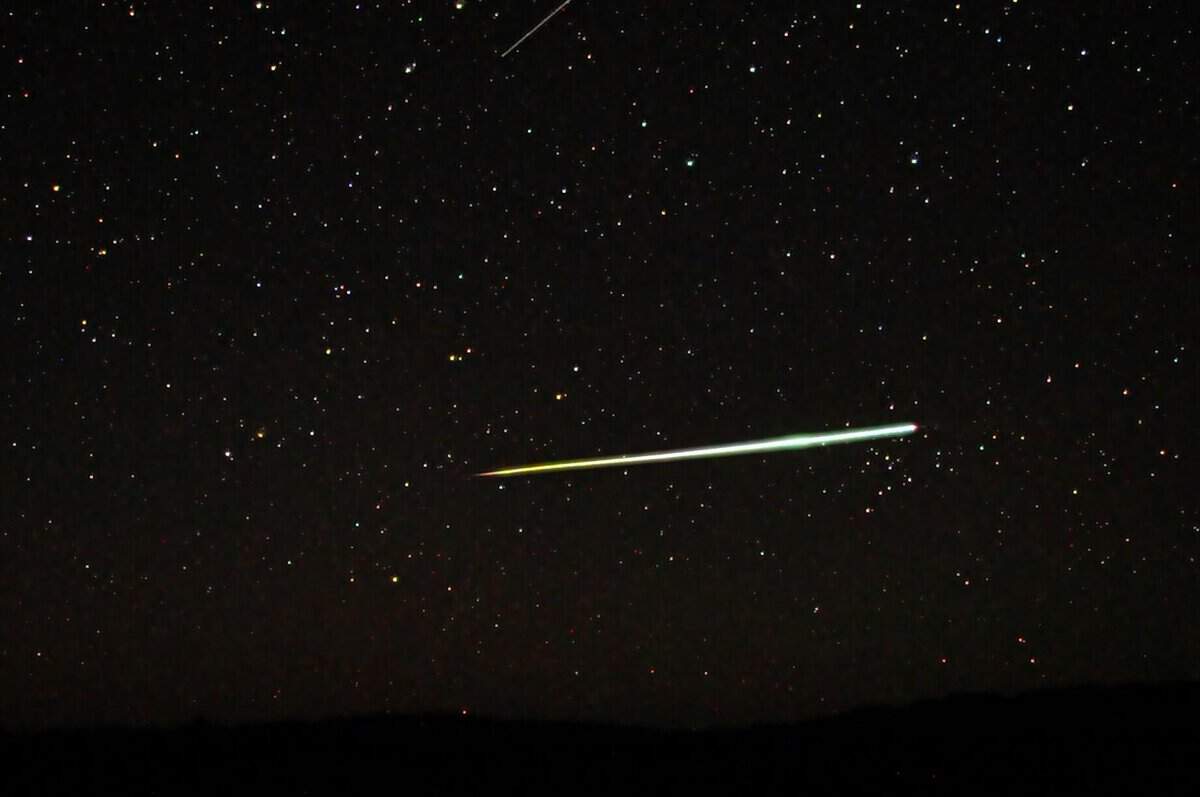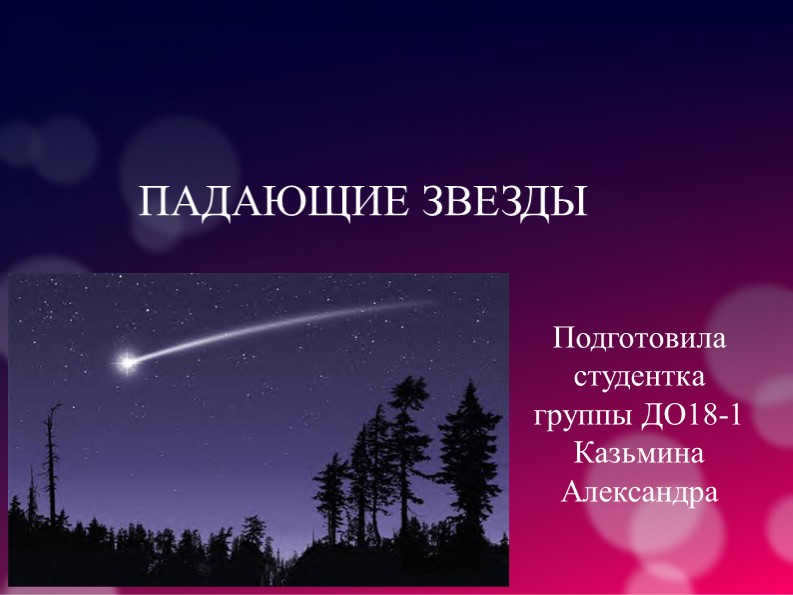
At present, there are extra cumulative discounts (ranging from 2% to 25%) accessible to 58,748 educational establishments. To ascertain which discount is applicable to all staff members of your educational institution, please sign in to your personal Infoworks account.


Get a professional course in retraining.
Engage in pedagogical activities by designing and implementing educational processes in general educational institutions (specifically in the subject of “Mathematics”).
In addition to this discount, you may also qualify for a discount from your educational institution based on the number of colleagues who have taken Infowork courses.
Currently, 58,748 educational institutions are eligible for additional discounts ranging from 2% to 25%. To determine the discount available to all employees of your educational institution, please log in to your personal Infoworks account.


Enroll in our professional development course today and enhance your skills as a hotel administrator.
Exclusive Discounts for Educational Institutions
Take advantage of our special discount offer! We can add your educational institution’s discount to our existing discounts, based on the number of colleagues who have already taken Infoworks courses.
Currently, we have discounts ranging from 2% to 25% for 58,748 educational institutions. To find out the specific discount applicable to all employees of your educational institution, simply log in to your personal Infoworks account.


Homeschooling. Tips and Tricks for Parents
Breakdown of the Presentation by Slide:


A presentation on the topic of FALLING STARS has been created by Alexandra Kazmina, a student from group DO18-1.
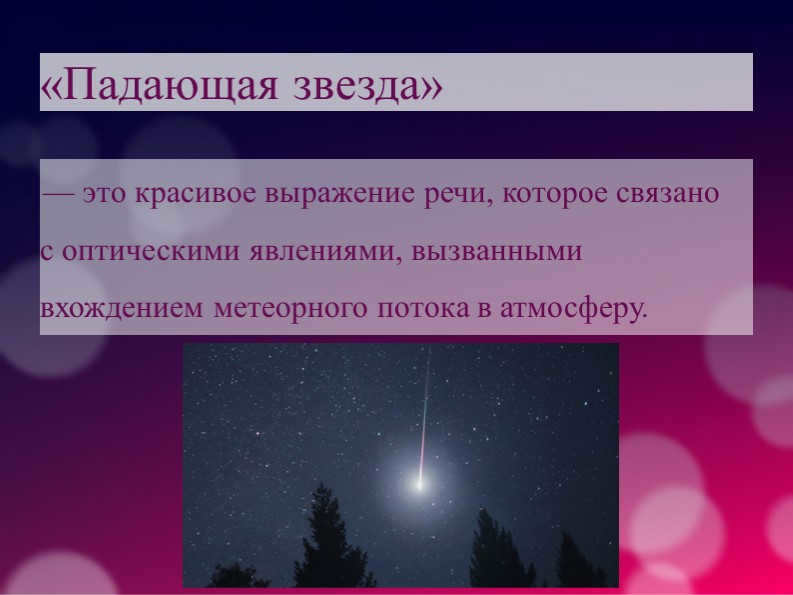

Slide 2: “Shooting star”
– is a delightful figure of speech that is connected to optical phenomena resulting from the entry of a meteor stream into the atmosphere.
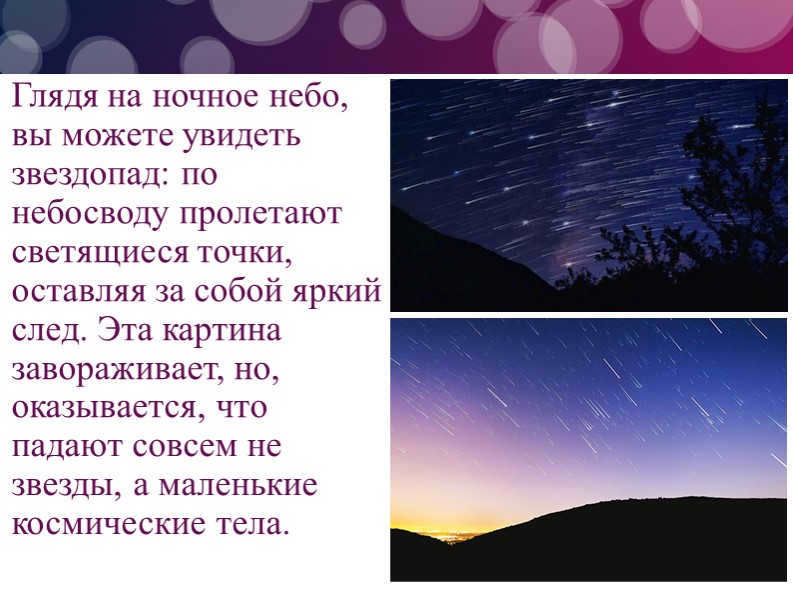

Slide number 3
When you observe the night sky, it is possible to witness a starfall: luminous specks soar through the vastness of space, leaving behind a radiant trail. This spectacle is truly captivating, however, it appears that it is not stars descending from the heavens, but rather small cosmic entities.

Slide 4 Can stars descend?
Stars are incapable of descending. They are colossal objects. To illustrate, the Sun is 109 times larger than the Earth, and yet it is merely referred to as a “yellow dwarf”. Stars possess their own gravitational force, which is significantly stronger than that of the Earth, making it more probable for objects to be drawn towards them rather than for stars to fall.
Moreover, stars are located at a great distance from the Earth. For instance, astronauts would need to travel for 81 thousand years to reach the closest star to us, Proxima Centauri. As a result, the motion of stars is imperceptible to the human eye.
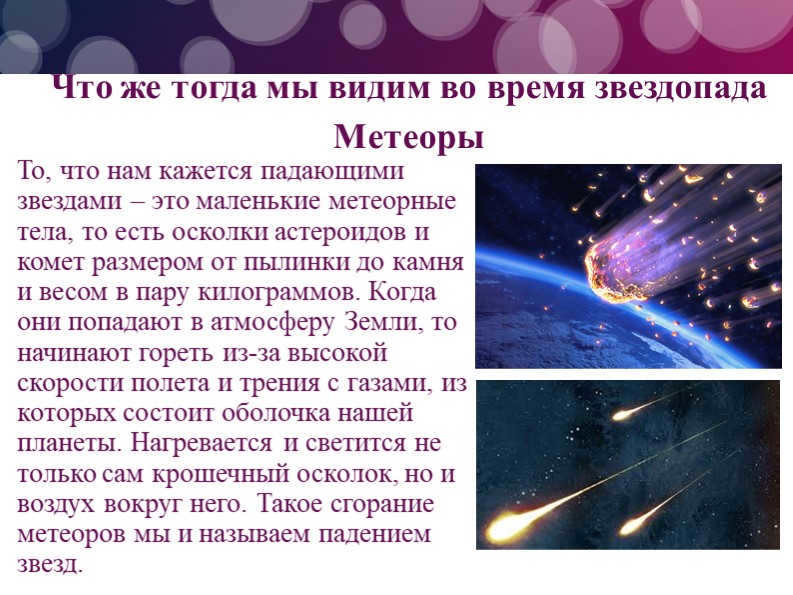

Slide 5 So, what exactly do we observe while engaging in the act of stargazing?
Meteors
What we commonly refer to as shooting stars are actually small celestial bodies, specifically fragments of asteroids and comets, varying in size from minuscule specks of dust to substantial rocks weighing a few kilograms. As these fragments enter the Earth’s atmosphere, they begin to incinerate due to their high velocity and the friction generated by the gases comprising our planet’s outer layer. Not only does the fragment itself heat up and emit a glow, but the surrounding air also undergoes the same process. This incineration of meteors is what we commonly refer to as the descent of stars.


Slide 6
Meteors can follow different paths: some meteors completely disintegrate as they pass through the atmosphere, while others descend to the Earth’s surface – these are known as meteorites. Meteors can also traverse the Earth’s atmosphere, partially disintegrate within it, and then exit back into space. In all of these scenarios, we will witness their sparkling “star-like” journey.


Slide 7
Despite the fact that the concept of a “falling star” is quite commonly used and denotes meteors that are trying to collide with the Earth’s atmosphere, few people are aware that there are actual falling stars, which are referred to as moving stars. These moving stars are enormous objects made up of glowing gas that are traversing space at speeds of millions of kilometers per hour.


Slide 8
The formation of moving stars is not a spontaneous occurrence. It occurs when a binary star system is engulfed by a supermassive black hole. In this scenario, one of the companions is consumed by the black hole while the other is accelerated and ejected at a high velocity from the system.

Slide 9 A glimpse into the past
Back in ancient times, astronomy was still a mystery to people, and they perceived the sky as a realm of enchantment. It was seen as the abode of divine beings, capable of granting mercy or retribution to mere mortals.
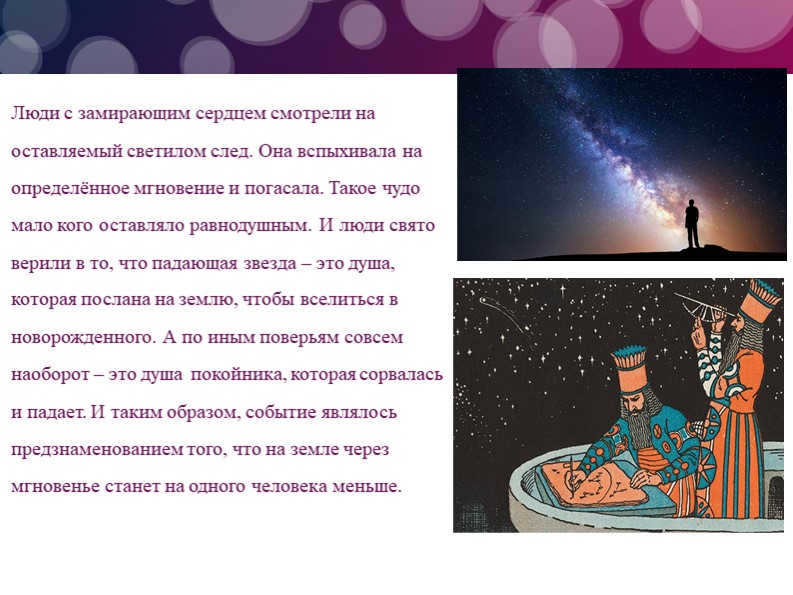

Slide 10
People gazed in anticipation at the luminous trail. It would flicker momentarily before disappearing. This extraordinary display left a lasting impression on many. People held the sacred belief that a falling star represented a soul descending to Earth to inhabit a newborn. Alternatively, it was believed to be the soul of a departed individual, detached and falling. Thus, this phenomenon served as a forewarning that someone would soon depart from the earthly realm.


Slide number 11
If you direct your gaze upwards and contemplate the boundless sky, you will discern the presence of pathways that lead into uncharted territories. It is no coincidence that the most prominent celestial pathway is known as the Milky Way.


Slide 13
However, once they arrived in the city, the locals immediately began to evade the unfamiliar visitors. And just as the constellations informed the residents of their mission, they were promptly apprehended and confined in a damp jail cell. According to the laws of Earth, they could have faced capital punishment, but there was one courageous individual who came to the aid of Andromeda and Perseus.
He guided them through the slumbering city, enabling them to make their way back to the heavens. Meanwhile, the young man remained in awe of the radiant beam of light that materialized seemingly out of thin air and vanished just as swiftly.


Slide 14
Did the journey go to waste? Absolutely not. If there are just a handful of individuals on this planet who are willing to believe in miracles and preserve them, they will be capable of guiding others. And as a gentle reminder, sometimes Andromeda releases stars from her hair to the ground, reminding humans that they are not alone, that they are being observed, and that miracles really do occur.


Resources and resources for teachers and educators
More than 10,000 educational materials for school and home learning


Most people have witnessed shooting stars at least once. Despite their name, shooting stars are not actually stars, but rather meteorites. It is widely known that falling stars are not possible. Stars are massive celestial bodies composed of gas, which are heated to extremely high temperatures and are located inconceivably far away from our planet. They are so distant that even their light takes decades, and sometimes even thousands, millions, or billions of years to reach us.
In reality, stars do not plummet towards Earth, as we previously believed, when we observe bright flashes in the nocturnal sky.
To clarify, shooting stars are not stars in the traditional sense. They are, in fact, meteors that enter Earth’s atmosphere and disintegrate at altitudes ranging from 80 to 120 kilometers.
There are specific dates when meteor streams occur, during which many meteors can be observed. For instance, the Perseids is an annual meteor shower that is visible in mid-August.
Therefore, it is not the stars that actually fall to Earth, but rather meteors that burn up in the atmosphere.
What are meteorites
If someone witnesses stars falling, what they are truly witnessing is the combustion of meteors – chunks of rock from outer space that have made their way to our planet. These meteors are relatively small, causing them to disintegrate completely in the dense layers of the atmosphere.
Occasionally, a meteor turns out to be an actual meteorite. This refers to a larger rock that is able to withstand the intense heat and pressure of the atmosphere and make it to the planet’s surface.


The observer is aware if stars are descending. Let’s delve into this intriguing phenomenon further. Meteorites are asteroids that have descended to the surface of the Earth. They hold immense fascination for scientists due to numerous reasons:
- Genuine celestial matter. The Earth was formed from an enormous cloud of gas and dust that revolved on its axis. As time passed, small clumps began to form within this cloud, eventually developing into small planets and then fully-fledged planets. Asteroids are remnants from that primordial era, fragments of matter that didn’t have the fortune to become part of a fully-formed planet. However, this means they contain valuable information about that period, which is why scientists diligently search for every meteorite that plummets to Earth.
- Guests from a different galaxy. Those who have studied the phenomenon of falling stars might ponder if it’s conceivable for visitors from other corners of the universe to make their way into our Solar System. The answer is yes. While there is currently no verified instance of a meteorite originating from another region of space landing on Earth, such an occurrence would undoubtedly revolutionize the field of science.
Meteor showers
We all know that stars sometimes fall from the sky. However, have you ever wondered why this phenomenon occurs more frequently in summer than in winter? Interestingly enough, this is not entirely accurate. Actually, stars are more likely to fall to Earth during winter in the southern hemisphere!
The explanation is quite simple. The Earth, along with the entire solar system, is constantly in motion through outer space. Although we may not perceive it, we are all moving at an incredible speed throughout the universe. Understanding what a shooting star is, we can deduce that in summer, our planet crosses paths with meteor showers. And indeed, this assumption is correct. Anyone can witness the beauty of a shooting star by simply looking up at the night sky during the Perseids meteor shower, which takes place in the warm summer months.
A celestial event known as a meteor shower occurs when a multitude of meteors, often referred to as “falling stars,” can be seen streaking across the sky. These meteor showers are closely linked with the presence of comets.
Comets are objects found within our solar system, consisting primarily of rocks and ice. As they approach the Sun, the ice begins to evaporate, producing a tail composed of dust and gases. As the comet continues its orbit around the Sun, it leaves behind a trail of gas and dust particles.
When the Earth passes through this trail, the particles of dust enter our planet’s atmosphere and ignite upon colliding with air molecules. This combustion gives rise to the radiant light that we perceive as a meteor or a “shooting star.” The number of meteors visible during a meteor shower is contingent upon the quantity of particles that enter the Earth’s atmosphere.
Thus, the creation of meteor streams is connected to comets that leave a path of gas and debris in their wake. When the Earth intersects this path, the debris particles enter the atmosphere and generate the meteors we observe as “shooting stars.”
The dimensions and velocity of meteors
Meteors, also known as shooting stars, can vary in size and velocity. They are generally smaller than typical asteroids or comets and travel at speeds ranging from 11 to 72 km/s. Meteors can range in size from large chunks of space rock the size of a melon to minuscule dust particles. The largest meteors, which can measure tens of meters in diameter, are referred to as bolides.
The velocity of meteors depends on their source and entry into the Earth’s atmosphere. In the case of meteors originating from comets, their speed can be relatively moderate, approximately 20-30 km/s. Conversely, meteors that come from asteroids can reach velocities of up to 72 km/s. Nevertheless, the velocity of a meteor is not constant, as it gradually decelerates while passing through the Earth’s atmosphere due to the presence of air resistance.
Influence on Culture
The discovery that shooting stars are actually meteors or meteorites is a relatively recent development. It is widely known that the Paris Academy of Sciences made this realization in 1772.
The prevailing belief at that time was that rocks cannot fall from the sky, that they cannot originate from outer space.
However, reality has proven to be much more fascinating than the beliefs held by people of that era. Modern scientists have definitively established that shooting stars are indeed meteors that originate from outer space. Occasionally, these meteors also arrive as fully-formed meteorites, serving as cosmic guests.
The notion that rocks cannot descend from the heavens has become a popular saying. Presently, science possesses a vast amount of knowledge, although not all-encompassing, and any contentious assertions must be investigated. There have been numerous instances where newcomers and experimenters have posed uncomfortable questions, put forth audacious hypotheses, tested them, and emerged triumphant.
Consider the case of Troy, for instance. The enigma of Troy was as significant as pondering the celestial bodies in the night sky. The prevailing belief for quite some time was that Troy was non-existent. However, Heinrich Schliemann, a self-taught archaeologist, took it upon himself to verify the existence of the ancient city and ultimately discovered Troy. This discovery is just as monumental as uncovering the reason behind the descent of stars from the sky.
While it remains uncertain if stars truly descend from the sky, numerous individuals persist in making wishes upon witnessing a celestial phenomenon. It is no surprise that the author of “The Little Prince” effectively encapsulated the essence of a shooting star when he penned:
I desire to comprehend the reason behind stars’ radiance… Perhaps, so that eventually, everyone can rediscover their own.
Burning Meteor
Readers were introduced to an extraordinary cosmic occurrence and learned about the concept of shooting stars. The process of meteors burning up in the dense layers of the atmosphere is just as awe-inspiring as the sight of actual stars falling from the sky, appearing as tiny needles in the dark expanse above.
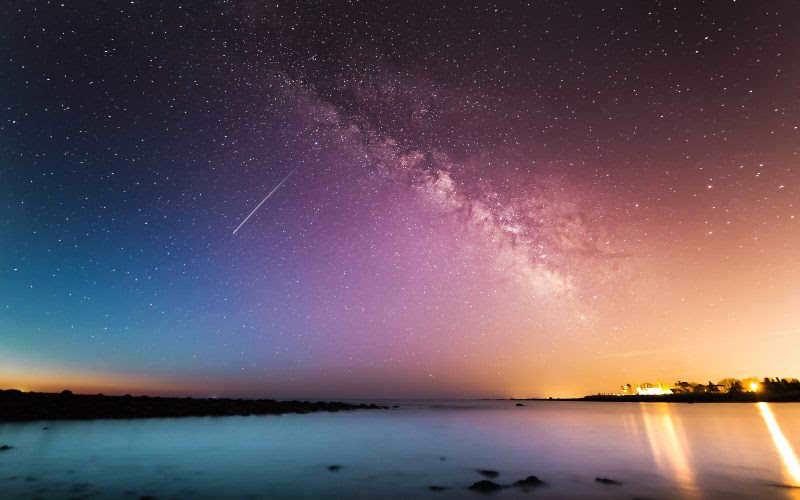
Perhaps due to this reason, the occurrence of a shooting star captivates the attention of individuals looking up at the night sky. Falling meteorites will persist, and individuals will continue to relish in this celestial phenomenon.
How to witness meteor streams and the optimal time to do so
Observing meteor streams is a captivating endeavor accessible to both astronomy enthusiasts and individuals who simply want to appreciate the splendor of the nocturnal heavens. You do not need to possess expertise in astronomy or possess sophisticated equipment – you only need to make preparations, select a suitable location and time.
It is crucial to bear in mind that optimal observations can be made when the weather conditions are favorable, with clear skies and no precipitation. Additionally, low temperatures can also hinder observations, so it is preferable to choose warmer weather.
To engage in meteor observation, specialized equipment is not necessary; regular binoculars or a telescope will suffice. However, for the utmost comfort during observation, a lounge chair can be utilized to ensure a relaxed position without straining the neck.
The most brilliant meteor showers of the year – such as the Perseids, Leonids, Delta Aquarids, and others – occur at specific times throughout the year. For instance, the Perseids can be observed in late July to early August, the Leonids in November, and the Delta Aquarids in July. Prior to observation, it is recommended to be aware of the dates and times of peak meteor activity for each shower.
It is crucial to keep in mind that the observation of meteor streams should not be considered as a single event. To maximize the number of meteors witnessed, it is essential to stay updated on the stream’s activity and plan ahead for future observations. Seeking advice from seasoned astronomers is also highly recommended. The observation of meteor streams offers an engaging and enlightening experience that is accessible to nearly all individuals.
Perilous celestial rocks
Meteoroids are solid entities hurtling towards the terrestrial sphere from the vast expanse of outer space. They can exhibit various dimensions, contours, and compositions. The most colossal meteoroids can surpass a diameter of 10 meters and weigh hundreds of tons, while smaller ones can be as minuscule as a grain of sand.
Meteoroids originate from cosmic objects such as asteroids and comets. As an asteroid or comet approaches Earth, it commences its interaction with the atmosphere. The air molecules in the object’s path heat up and compress, giving rise to a luminous streak commonly referred to as a “starburst.” If the object is of sufficient magnitude, it may not completely disintegrate in the atmosphere and descend onto the Earth’s surface.
Meteorites can have various impacts on Earth, depending on their size and velocity. Small meteorites typically burn up in the atmosphere, posing no threat to life or property on Earth. However, larger meteorites can cause extensive damage upon impact with the Earth’s surface.
For instance, the Chelyabinsk meteorite, which descended approximately 20 meters in 2013, shattered windows in buildings and injured over 1,000 individuals. Another example is the Tunguska Taiga meteorite that plunged to Earth in 1908, releasing an enormous amount of energy equivalent to the detonation of more than 10 megatons of explosives.
In addition, a meteorite collision can create a crater on the Earth’s surface. Some of the largest craters, like the Chishulub Crater in Mexico, are linked to meteorite impacts and can have a significant impact on the environment.


There are various interpretations associated with spotting a shooting star. Typically, when someone witnesses the descent of a celestial body, they reflect on their deepest desires that need fulfillment. However, it is unclear whether these desires will come true, as there are many factors to consider such as timing, location, and the state of the sky. In reality, seeing a shooting star is considered a positive sign.
The condition of the sky has always aided humanity in determining the trajectory of movement, potential weather patterns, and long-term climate forecasts. Many beliefs are intertwined with the celestial bodies and their movements.
What is the significance of witnessing a shooting star?
According to various online sources and books, a shooting star is often seen as a positive sign or omen. It is believed that if you make a wish at the exact moment the star starts to fall, it has a higher chance of coming true. However, this belief emphasizes the importance of timing, as the wish may not be granted if made after the star has fallen.
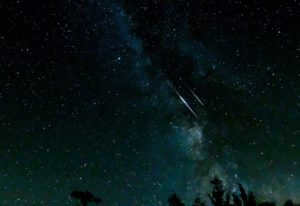
The cosmic luminary is regarded as the spirit of a deceased ancestor who desires to assist and bring about the speedy realization of a wish.
It greatly depends on one’s mood – an optimist will believe in what they have witnessed, while a pessimist will be disappointed, as a falling star symbolizes another problem.
One must quickly determine which belief is closer to their heart and reflect on past events: perhaps changes in the past were connected to wishes directed towards the sky.
In ancient times, falling stars were able to predict the fate of famous rulers and states. The ancients believed that no joyful news would follow the fall of a star, only a bad omen signaling imminent death.
There are numerous individuals who encounter the vision of a star while they are dreaming. The act of seeing a star and managing to make a wish in that moment is believed to bring about actual success in one’s life. However, if one happens to see a large number of stars in their dream, it could be an indication of potential troubles that may arise in their personal life or at their workplace. Additionally, if someone is pointing a finger towards the stars in their dream, it is advised to pay closer attention to their health and well-being.

If a star descends, signs can change. The most frequent:
- The occurrence of negative information, impending sorrow.
- The direction of descent also plays a significant role: if the fall is observed from right to left – there will be positive outcomes, vice versa – sorrows;
- Addition of a new member to the family;
- Achievement of the deepest desire.
It is crucial to properly prepare if you desire to make a wish. Always keep your dream in mind and dedicate the necessary time to formulate your thoughts correctly and clearly. This phenomenon is not uncommon, and one can witness it happening even on a daily basis. Therefore, it is advisable to reveal the next secret only after the previous one has been fulfilled. It is not recommended to share your plans before they are realized for several reasons: people can often hinder the fulfillment of your wishes due to their envy, negative thoughts, or differing opinions. Each person has their own individual value system, thinks differently, and desires simple, practical things, while many aspirations may seem unattainable.
When the signs cannot gaze at the night sky
There exist certain days, as stated by folk wisdom, when it is not advisable to witness the descent. This caution arises from the potential danger it poses to the observer and their surroundings:
According to some sources, it is preferable to minimize venturing outside the house on March 5th and also on July 28th. If one happens to spot a celestial object descending on these nights, it is unlikely to bring good fortune; rather, it signifies the loss of a beloved individual. The belief holds that the stars that descend during the night are the souls of those who transgressed in their lifetime and are now grappling to find solace. They yearn for earthly absolution and can only find their rightful place once they have obtained it.
These souls can inadvertently cause harm to the living.
To safeguard oneself from such a sight, it is advised to shut the windows at night and place an icon or any other protective amulet near the entrance.
Conclusion
When a falling star is seen, it can carry either a positive or negative meaning. The message sent down by the sky cannot be interpreted unambiguously. The falling star may be a good omen for one person, but it may promise worries for another. To interpret it, one should consider the direction of the cosmic object and be cautious in March and July. The thought should reflect the inner experience that needs resolution. One should think about whether the change is possible and how much is necessary. It is difficult to determine if this is something true or just an element of self-hypnosis. However, one thing is certain – one should live their life in a way that future generations will remember them as a vivid impression and can rely on their support and guidance.
The Perseid meteor shower, also known as the Perseid starfall, is an absolutely captivating celestial event. The year 2023 will bring the peak of this mesmerizing phenomenon, with a staggering rate of up to 150 meteors per hour, all throughout the middle of August. Allow us to guide you on where to witness the awe-inspiring Perseids meteor shower in the enchanting St. Petersburg and the surrounding Leningrad region, as well as inform you on its commencement and duration.

Every summer, during the last weeks of the season, a magnificent meteor shower takes place in the distant constellation Perseus. This breathtaking celestial event is known as the Perseids, named after its “home.” It is widely regarded as the most awe-inspiring and eagerly anticipated stargazing phenomenon of the year, surpassing the fame of other meteor showers like the Quadrantids in January or the Lyrids in April.
The Perseids meteor shower consists of fragments that originate from comet 109P/Swift-Tuttle, which was first observed in 1862.
Nonetheless, the Perseids have been captivating individuals for centuries: historical records indicate that this astonishingly stunning event has been documented in Chinese and Japanese texts dating back to the 3rd and 4th centuries. In Italy, this celestial spectacle is affectionately referred to as “the tears of St. Lawrence”. The reason behind this name is that in the midst of August, Italians honor this revered saint, who is also regarded as the guardian angel of the less fortunate.
Omen and significance of the Perseids meteor shower
August is the optimal time to “make a wish” upon a falling star. Admittedly, this belief may not be taken seriously, but why not indulge in a little dreaming? Especially since there will be an abundance of shooting stars in the middle of the month!
However, it is important to make your wish correctly in order for it to come true. Firstly, the wish must be incredibly strong, the most personal. Additionally, it is believed that you must have enough time to make your wish before the star disappears, otherwise it will not be fulfilled. Therefore, it is essential to formulate your cherished dream in a concise and clear manner ahead of time, so that you can quickly say it to yourself at the most crucial moment.
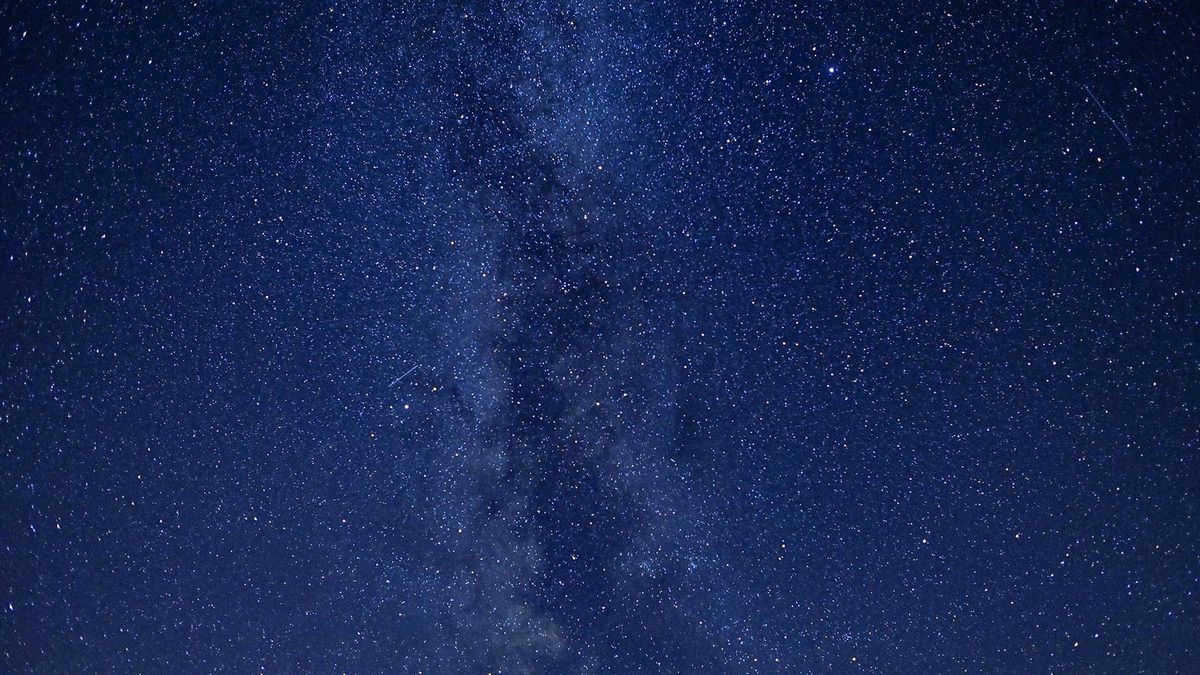
Astrologers suggest tidying up your home and getting rid of any clutter you’ve collected since the morning of the day you plan to stargaze. This will create space for new energy.
The optimal way to make wishes on shooting stars is to do so alone, allowing yourself to connect with nature. There’s no need to make multiple wishes for each shooting star – one heartfelt request to the Universe is enough. After the ritual, it’s important not to engage in conversation with anyone to conserve energy, and ideally, it’s best to go to bed right away.
In ancient times, our ancestors associated shooting stars with various omens. One belief was that if a shooting star appeared on the left side, it foretold misfortune, while if it appeared on the right side, it promised joy and good luck. However, some believed that they could avoid fate by quickly turning to face the shooting star on the right side.
There were also certain days when it was advised not to gaze at the sky at all, in order to avoid accidentally spotting a shooting star. Our ancestors believed that on July 28 (15) (the day of Ulita and Kirik’s memory) and on March 5/20 February (the day of St. Leo of Catania’s memory), a shooting star indicated a great misfortune or illness.
Nowadays, of course, these omens are no longer believed, but many people still turn to face their right side when they spot a falling celestial body, just in case. After all, who knows what the universe has in store?
When does the Perseid meteor shower start?
The Perseid meteor shower started on July 14, 2023, and will continue until August 24th. The peak activity of the meteor shower is expected in mid-August.
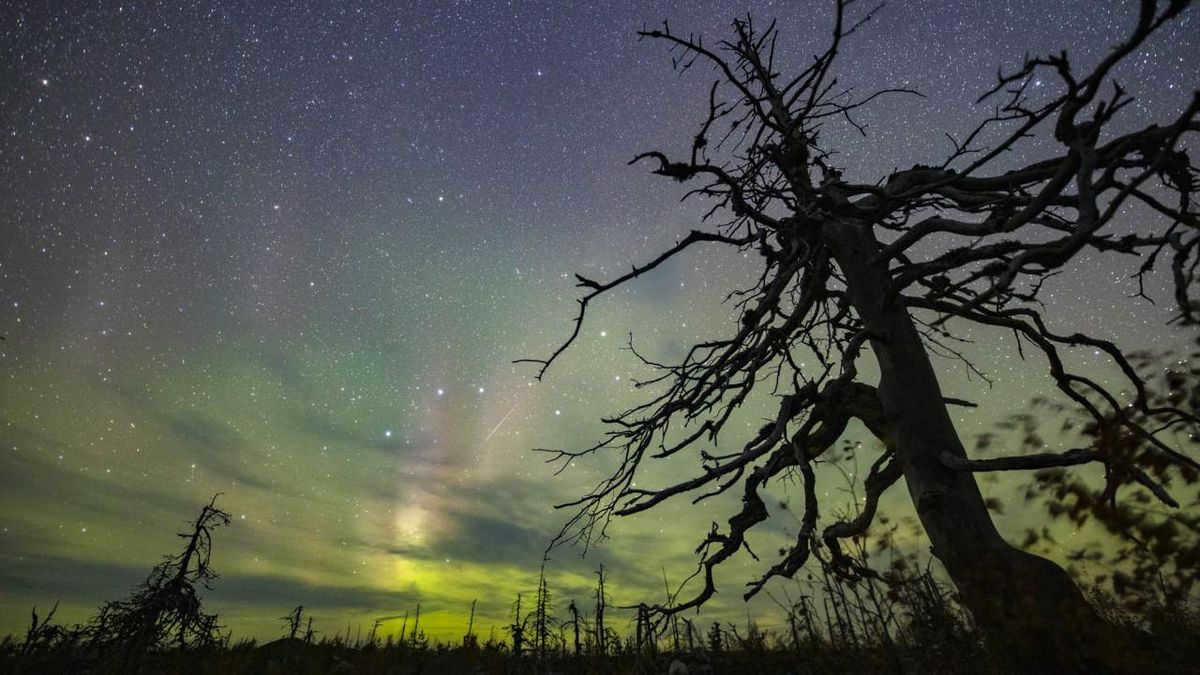
It’s worth mentioning that astronomers are predicting that this year’s Perseids meteor shower will be one of the most brilliant that humankind has ever witnessed. Furthermore, the moonlight won’t interfere with the observations during these days because our natural satellite is currently in its waxing phase, appearing in the sky as a slender crescent.
When is the peak of Perseids stargazing?
The peak of Perseids stargazing occurs between August 11 and August 13, during which you can witness the magnificent sight of 100 or even 150 meteors crossing the sky every hour. However, even after these dates, there will still be a significant number of meteors to observe. So, if you happen to miss the most spectacular night, there is no need to worry as you will still have an opportunity to admire the meteor shower and make wishes. The only requirement is favorable weather conditions that won’t disappoint you.
According to scientists, a highly impressive celestial event known as the “star show” will be visible to residents across the entire Northern Hemisphere. This means that lucky individuals in St. Petersburg will have the opportunity to witness this stunning display. Assuming that the weather conditions are favorable and clouds do not obstruct the view, residents of the Northern Capital of Russia will be able to fully immerse themselves in the awe-inspiring spectacle of the star fireworks. However, the question remains: where is the optimal location in St. Petersburg to observe the Perseids meteor shower?
Regrettably, urban dwellers are often hindered in their stargazing endeavors by the intense illumination emitted from electric lights. Consequently, it is advisable to venture outside of the city, seeking out areas that are as far away from artificial light sources as possible. Nevertheless, if leaving the city is not a feasible option, it is worth scouting for the darkest corners of St. Petersburg that provide a suitable vantage point for observation.
Experienced hobbyist stargazers often take up strategic positions atop tall buildings: where the glow from street lamps, windows, and passing cars is minimal. However, this pursuit is not without its hazards, so caution must be exercised. Alternatively, one can find a serene spot in a park or public garden.
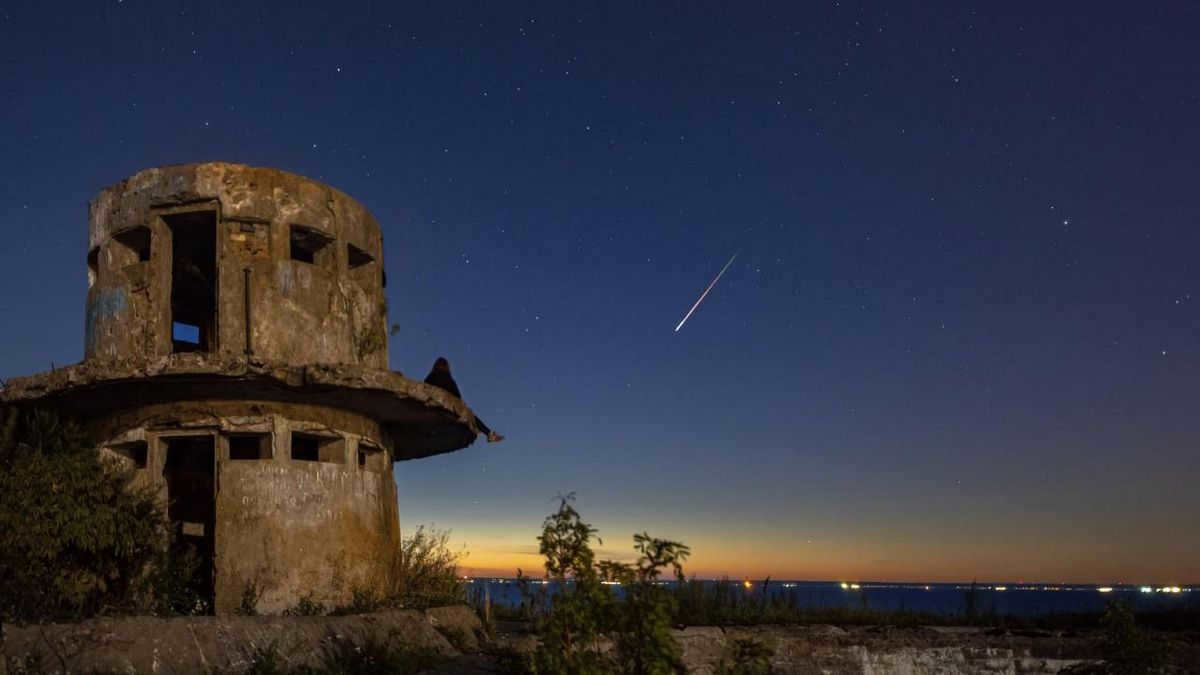
A more advanced option would be to visit an observatory. For instance, the Pulkovo Observatory occasionally offers evening tours for both adults and children. However, it is advisable to purchase tickets for exclusive nighttime events at the St. Petersburg planetarium.
Best Spots in the Leningrad Region to Witness the Perseids Meteor Shower
If you want to have an unforgettable experience watching shooting stars, the Leningrad Region is the perfect destination to witness the Perseids meteor shower. We have compiled a list of picturesque locations where you can enjoy this breathtaking celestial event without any distractions.

- Lake Yastrebinoe, located in the Priozersky district, offers perfect darkness for stargazing due to its remote location in the forests. The addition of its incredibly beautiful rocky shores adds a touch of romance to your observation experience.
- Kaibolovo, situated in the Tosnensky district, is an old Finnish village that offers one of the darkest skies in the Leningrad region. The village is also surrounded by mysterious legends, creating an unforgettable fairy-tale atmosphere.
- The Observatory on Lake Svetloye, located in the Priozersky district, is the only place in our region where you can observe the stars through the giant radio telescope RTF-32. However, visiting the observatory requires prior arrangement.
- Koporie, situated in the Lomonosov district, is well-known for its fortress and its excellent conditions for observing the Perseids meteor shower. Only 100 km away from St. Petersburg, this village offers a complete escape from light pollution with its utterly dark nights.
- The village of Pogi, located in the Tosnensky district, is highly recommended for stargazing trips from Petersburg. It is conveniently situated just 60 km away from the city center and is renowned for its exceptionally dark nights.

